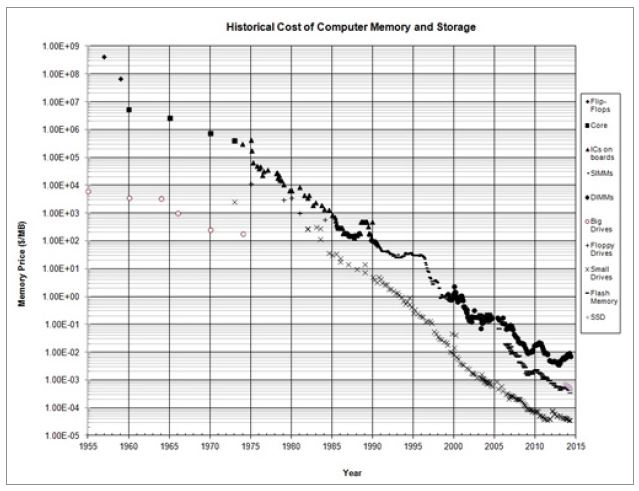This article is the second in an editorial series that will provide direction for enterprise thought leaders on ways of leveraging in-memory computing to analyze data faster, improve the quality of business decisions, and use the insight to increase customer satisfaction and sales performance.
In-memory computing primarily relies on keeping data in a server’s RAM instead of much slower spinning disk or flash devices and massive parallelization as a means of processing at faster speeds. In-memory computing especially applies to processing problems that require extensive access to data analytics, reporting, data warehousing, high-speed transactions and big data applications as mentioned in last week’s article.
 A confluence of factors have contributed to the strong business case for IMC, including the steep upward slope for the collection of business data, the demand for analytics approaching real-time, and increased complexity of business software applications. In light of these trends, added performance translates directly into clear business value:
A confluence of factors have contributed to the strong business case for IMC, including the steep upward slope for the collection of business data, the demand for analytics approaching real-time, and increased complexity of business software applications. In light of these trends, added performance translates directly into clear business value:
- With IMC you can use less hardware to (i) support the required SLAs directing performance and throughput, (ii) get better data center consolidation, and (iii) significantly reduce capital costs, as well as infrastructure and operational overhead.
- With IMC you can significantly extend the lifetime of your existing hardware and software by getting increased performance and improve its ROI by using your current infrastructure longer and making it perform better.
And that’s what makes IMC such a hot topic these days: the demand to process ever growing data sets in real-time can now be fulfilled with the extraordinary performance and scale that IMC affords. Enterprise-ready solutions using IMC technology can help companies analyze data faster, improve the quality of their business decisions, and use the insight to increase customer satisfaction and sales performance. With the economies-ofscale equation so compelling, the business case becomes clear and obvious.
Gartner reported in 2013 that IMC is racing towards mainstream adoption. “The relentless declines in DRAM and NAND flash memory prices, the advent of solid-state drive technology and the maturation of specific software platforms have enabled IMC to become more affordable and impactful for IT organizations,” said Massimo Pezzini, vice president and Gartner Fellow. Since 1995, DRAM and NAND flash memory prices have plunged from approximately $30/MB to $.0073/MB. The graph below shows memory prices decreasing with time (1957 – 2014) courtesy of John C. McCallum.
IMC is an inexpensive means for speeding up enterprise software applications, including but not limited to analytics. The question, however, is what do we mean by speed-up? If we mean a speed gain of 2-3x performance or scalability improvements, then flash storage is the path of least resistance. This route is most inexpensive and provides a modest increase in performance. But what we now think of as IMC, extends well beyond this level of performance gain.
IMC used to be a strategy only for larger enterprises with deep pockets, but now due to the significantly deceased price of RAM, businesses of all sizes can take advantage of this technology to process real-time data. The main advantage of IMC is the storage of data in the RAM on multiple servers, which decreases the impact of the data on performance. By storing data in RAM instead of on a mechanical spinning disk, the performance increases exponentially. Without IMC, companies do not have access to the full capabilities of technologies such as big data. A company simply cannot maximize the business impact of today’s technology without access to both data and performance.
As an example of a real-life use case for IMC, consider a client engagement that IMC industry leader GridGain won with one of the largest banks in the world. The solution called for a risk analytics system to provide real-time analysis of risk for the bank’s investment portfolio (a common use case for IMC in the financial industry). GridGain software demonstrated 1 billion (full ACID) business transactions per second using 10 commodity servers with a total of 1TB of RAM. The total hardware cost for the 10 commodity servers was less than $25,000. This example demonstrates a dramatic business case for IMC. IMC did not just provide a mere 2-3x performance boost, but rather a staggering 100x of what is theoretically possible using the most expensive flash-based storage available on today’s market. 1TB of flash-based storage alone would cost 10x of entire hardware setup mentioned above. Hard disks wouldn’t even have been in the same realm of consideration.
IMC’s impact is increasingly manifesting as notable innovation in business processes. Well-established industries and application areas already
have adopted IMC including: manufacturing resource planning (MRP), corporate performance management, dynamic pricing and supply chain
planning (SCP), insurance claim processing and modeling, medical image processing, natural language processing, real-time machine learning,
real-time ad platforms, investment banking, and much more. It is clear that these use case examples are driven by the underlying technical need, not by the specific industry. The end goal for any data environment should be delivering precisely the right information to the right people quickly enough for prompt action—IMC certainly facilitates this goal. Longer term, even more innovation is destined to emerge as more IMC-enabled packaged business applications are released in the market.
Next week’s article will look at Types of In-memory Computing. If you prefer the complete insideBIGDATA Guide to In-Memory Computing is available for download in PDF from the insideBIGDATA White Paper Library, courtesy of GridGain.





Speak Your Mind